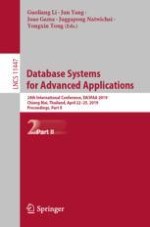This two-volume set LNCS 11446 and LNCS 11447 constitutes the refereed proceedings of the 24th International Conference on Database Systems for Advanced Applications, DASFAA 2019, held in Chiang Mai, Thailand, in April 2019.
The 92 full papers and 64 short papers were carefully selected from a total of 501 submissions. In addition, 13 demo papers and 6 tutorial papers are included. The full papers are organized in the following topics: big data; clustering and classification; crowdsourcing; data integration; embedding; graphs; knowledge graph; machine learning; privacy and graph; recommendation; social network; spatial; and spatio-temporal. The short papers, demo papers, and tutorial papers can be found in the volume LNCS 11448, which also includes the workshops of DASFAA 2019.
